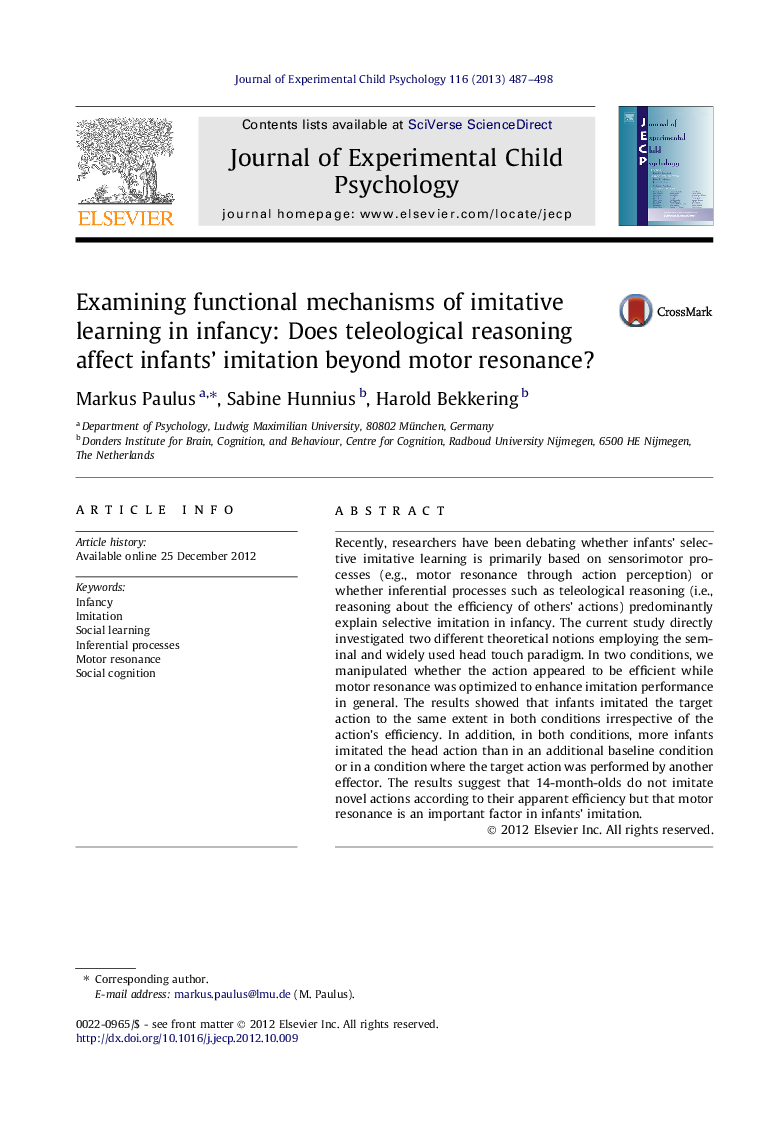| کد مقاله | کد نشریه | سال انتشار | مقاله انگلیسی | نسخه تمام متن |
|---|---|---|---|---|
| 10453099 | 919457 | 2013 | 12 صفحه PDF | دانلود رایگان |
عنوان انگلیسی مقاله ISI
Examining functional mechanisms of imitative learning in infancy: Does teleological reasoning affect infants' imitation beyond motor resonance?
ترجمه فارسی عنوان
بررسی مکانیسم های عملکردی یادگیری تقلیدی در دوران کودکی: آیا استدلال افسانه ای بر روی تقلید نوزادان در خارج از رونق حرکت موثر است؟
دانلود مقاله + سفارش ترجمه
دانلود مقاله ISI انگلیسی
رایگان برای ایرانیان
کلمات کلیدی
نوزادان، تقلید، یادگیری اجتماعی، فرآیندهای استنتاج، تشدید حرکت موتور، شناخت اجتماعی،
ترجمه چکیده
اخیرا محققان بحث کرده اند که آیا یادگیری تقلیدی انتخابی نوزاد به طور عمده براساس فرایندهای حسگر حرکتی (به عنوان مثال، تشدید حرکتی از طریق ادراک عمل) یا اینکه فرآیندهای استنباطی مانند استدلال تئولوژیک (یعنی استدلال در مورد کارآیی اقدامات دیگران) به طور عمده انتخابی تقلید در دوران کودکی مطالعه حاضر به طور مستقیم دو مفهوم نظری مختلف را با استفاده از الگوی پارامتر لمسی پایه و به طور گسترده ای مورد استفاده قرار می دهد. در دو حالت، ما دستکاری کردیم که آیا عملکرد به نظر می رسد کارآمد است در حالی که رزونانس موتور بهینه شده است برای افزایش عملکرد تقلید به طور کلی. نتایج نشان داد که نوزادان اقدام هدف را به همان اندازه در هر دو حالت تقلید می کنند، صرف نظر از کارایی عمل. علاوه بر این، در هر دو حالت، نوزادان بیشتر عمل سر را تقلید می کنند تا در شرایط اضافی پایه یا در شرایطی که عمل هدف توسط یک اثر کننده دیگر انجام می شود. نتایج نشان می دهد که 14 ماهه ها اقدامات جدید را با توجه به کارایی ظاهری آنها تقلید نمی کنند بلکه تشدید حرکتی عامل مهمی در تقلید نوزادان است.
موضوعات مرتبط
علوم انسانی و اجتماعی
روانشناسی
روانشناسی رشد و آموزشی
چکیده انگلیسی
Recently, researchers have been debating whether infants' selective imitative learning is primarily based on sensorimotor processes (e.g., motor resonance through action perception) or whether inferential processes such as teleological reasoning (i.e., reasoning about the efficiency of others' actions) predominantly explain selective imitation in infancy. The current study directly investigated two different theoretical notions employing the seminal and widely used head touch paradigm. In two conditions, we manipulated whether the action appeared to be efficient while motor resonance was optimized to enhance imitation performance in general. The results showed that infants imitated the target action to the same extent in both conditions irrespective of the action's efficiency. In addition, in both conditions, more infants imitated the head action than in an additional baseline condition or in a condition where the target action was performed by another effector. The results suggest that 14-month-olds do not imitate novel actions according to their apparent efficiency but that motor resonance is an important factor in infants' imitation.
ناشر
Database: Elsevier - ScienceDirect (ساینس دایرکت)
Journal: Journal of Experimental Child Psychology - Volume 116, Issue 2, October 2013, Pages 487-498
Journal: Journal of Experimental Child Psychology - Volume 116, Issue 2, October 2013, Pages 487-498
نویسندگان
Markus Paulus, Sabine Hunnius, Harold Bekkering,
